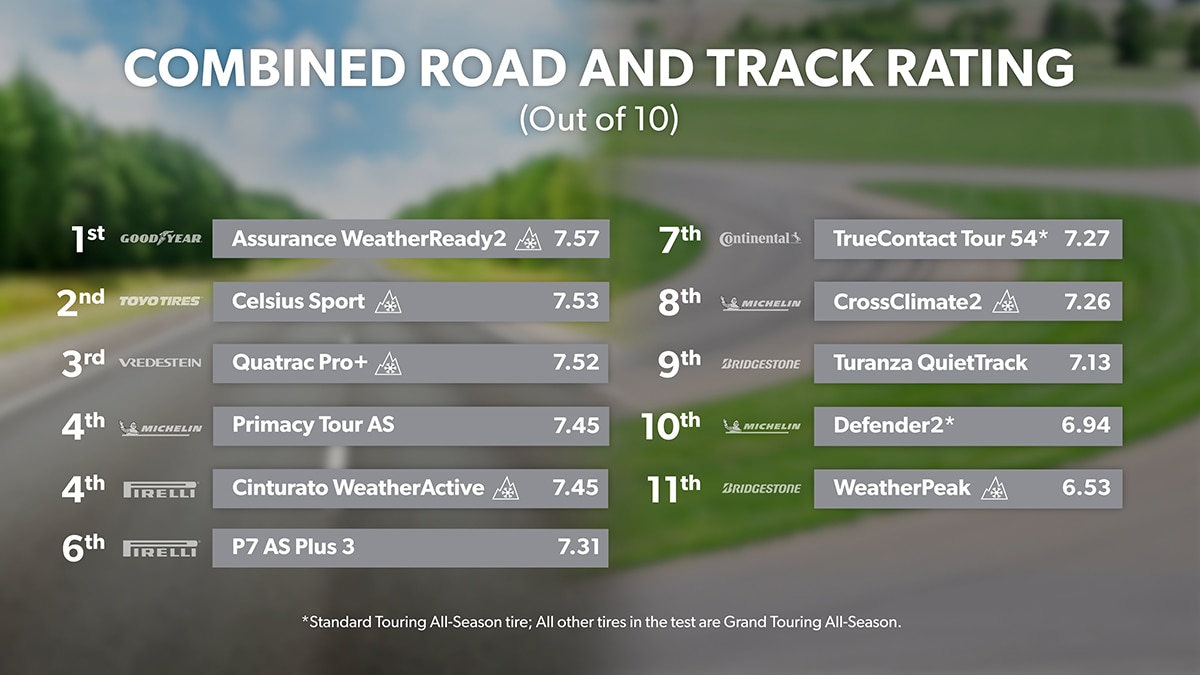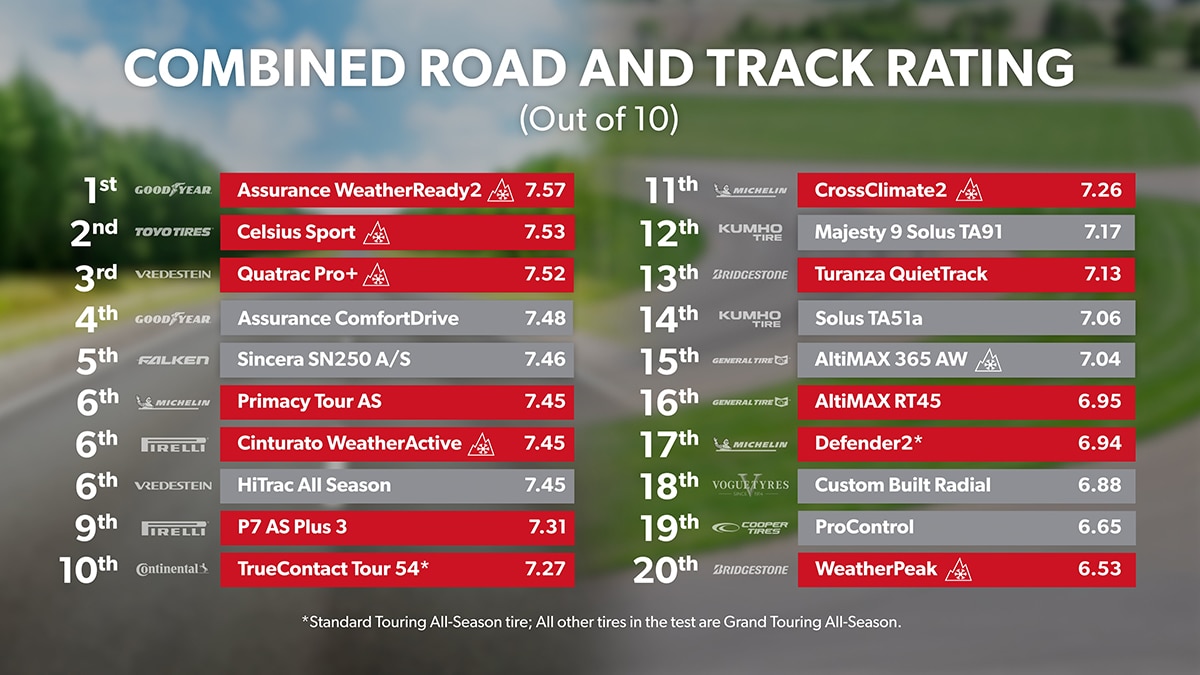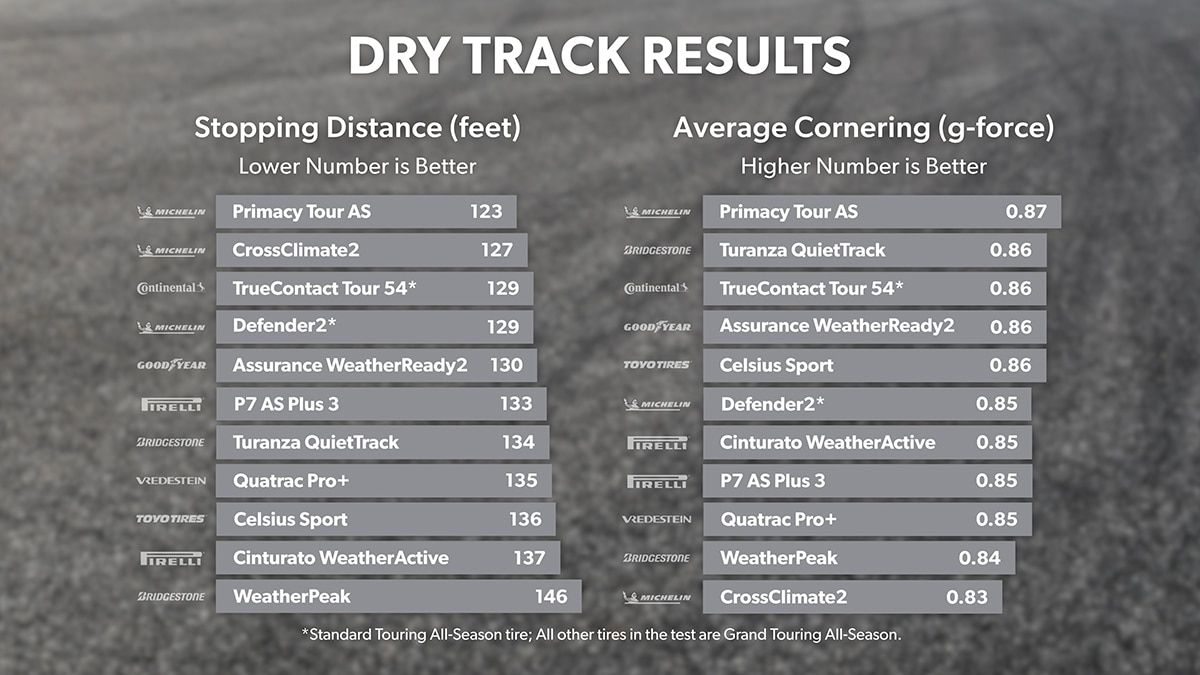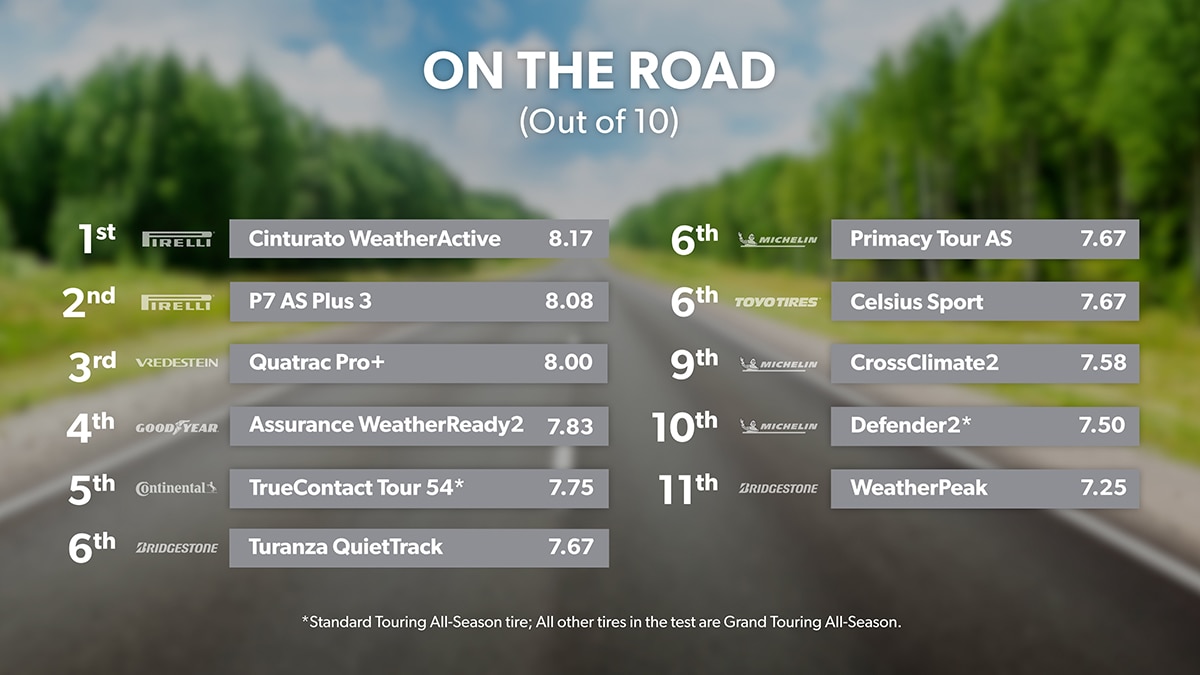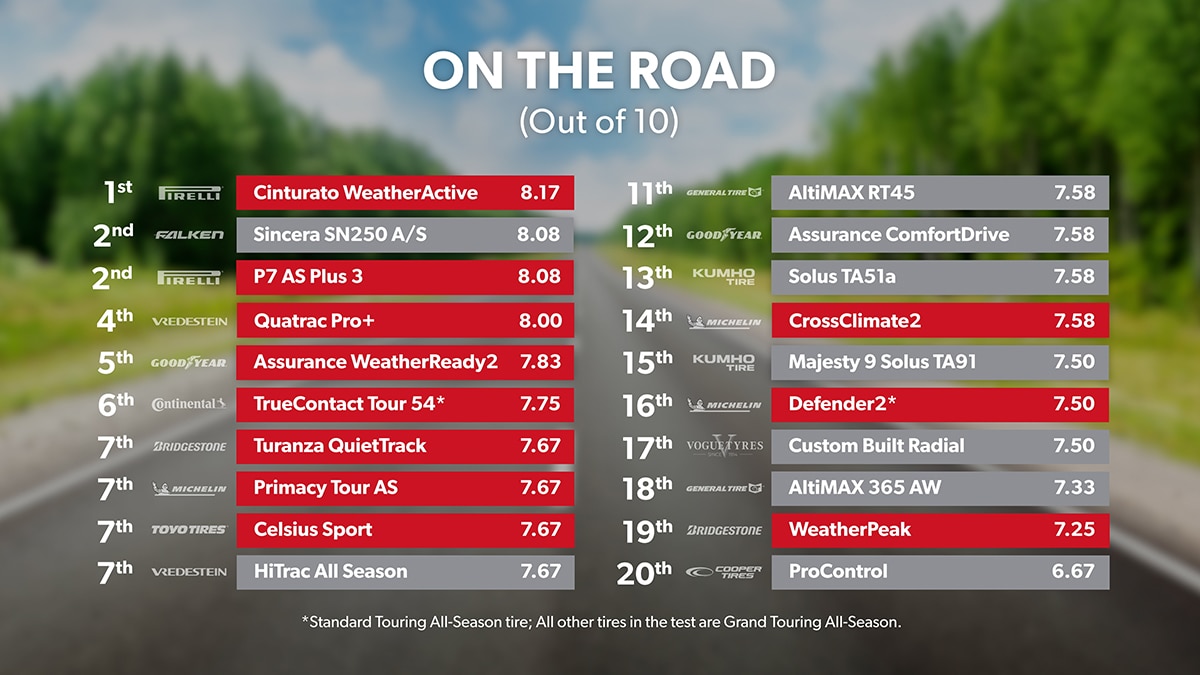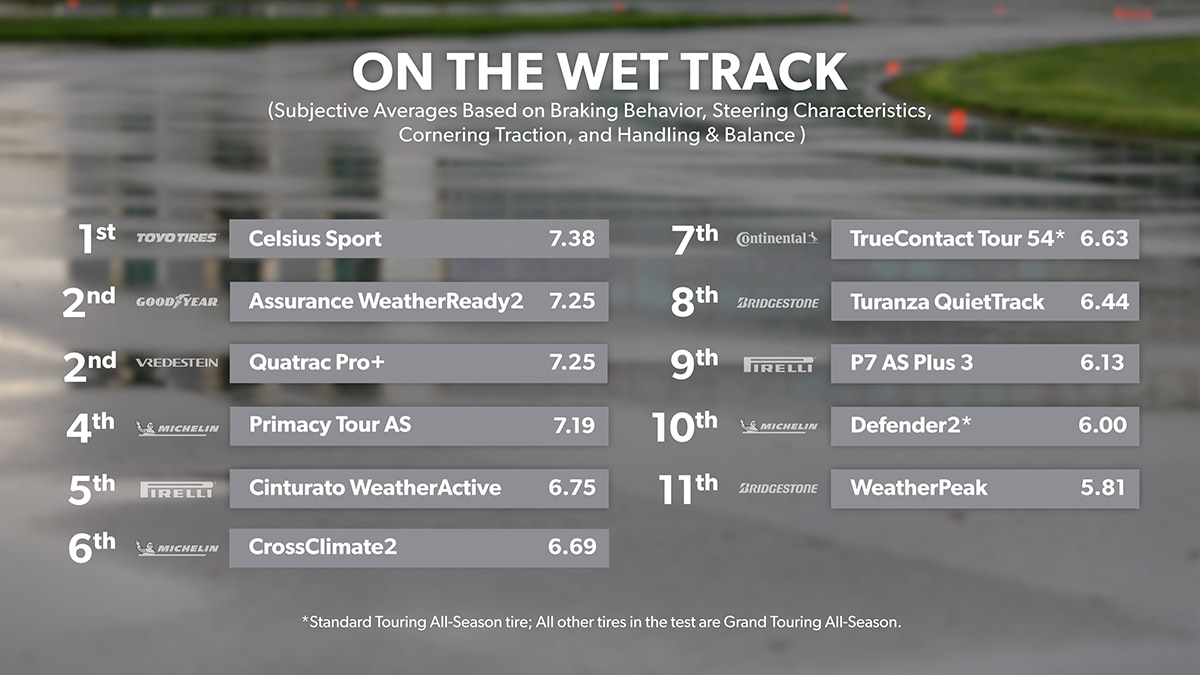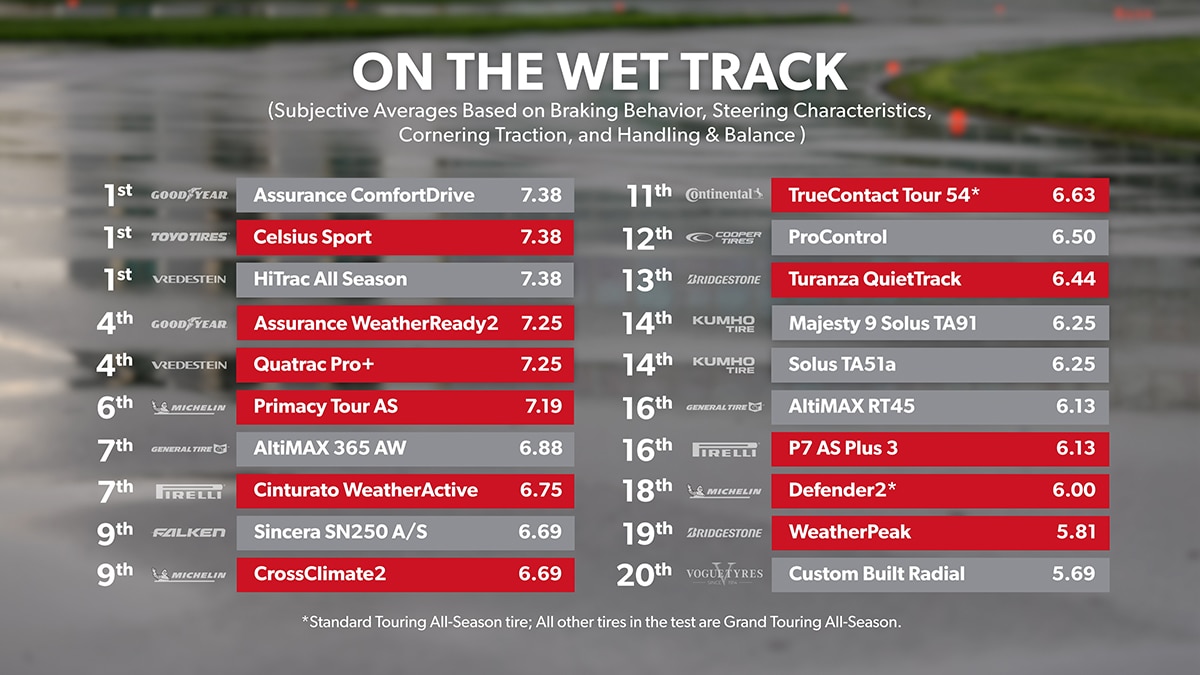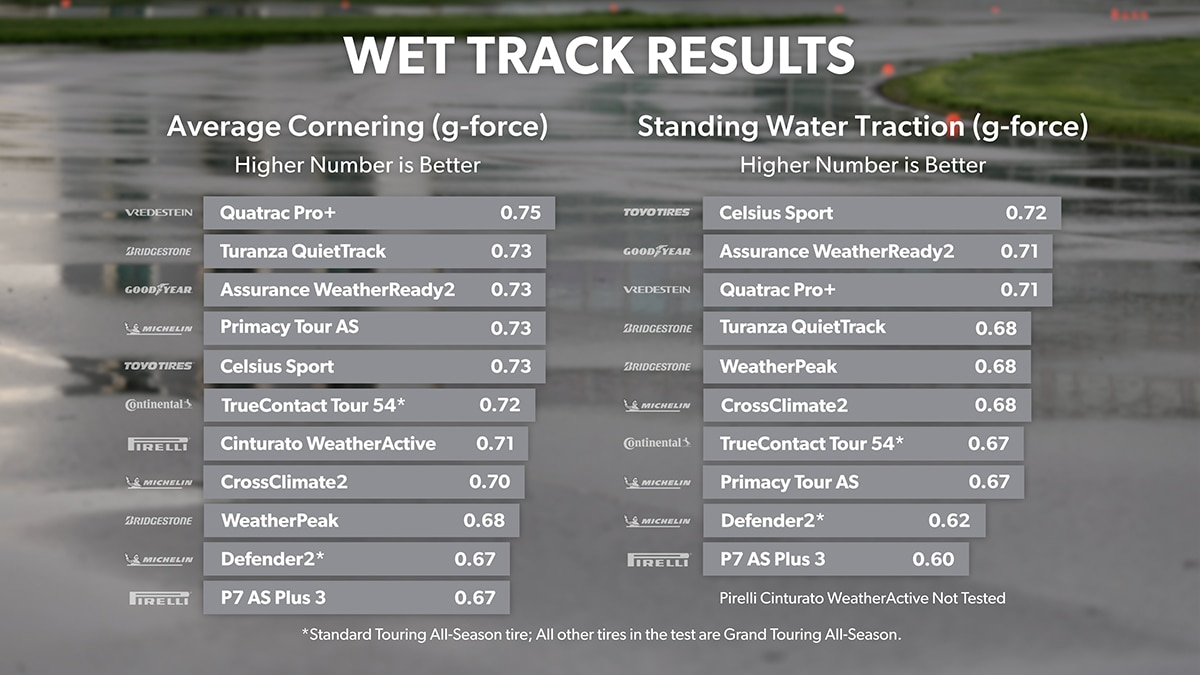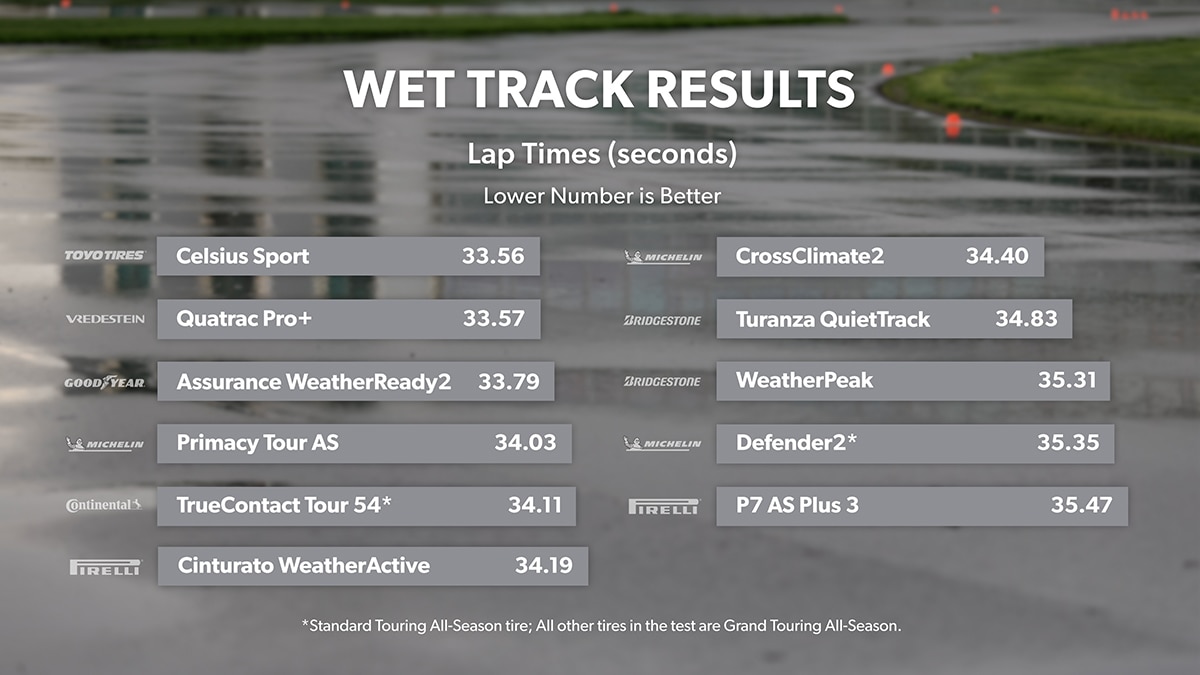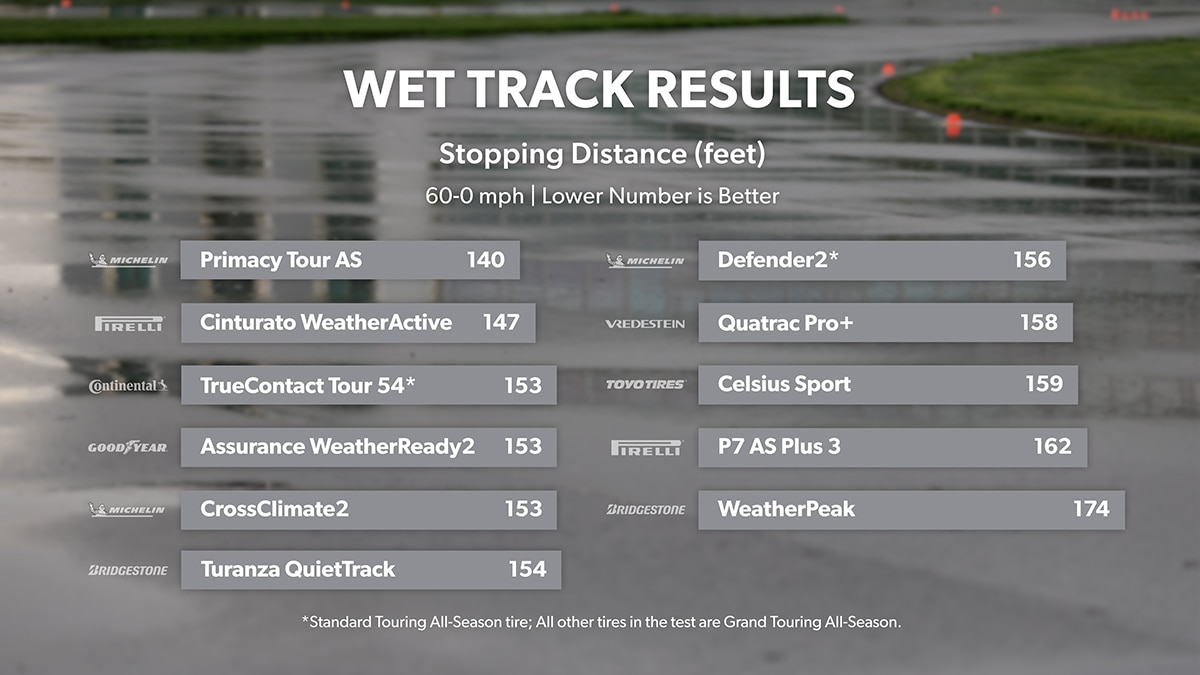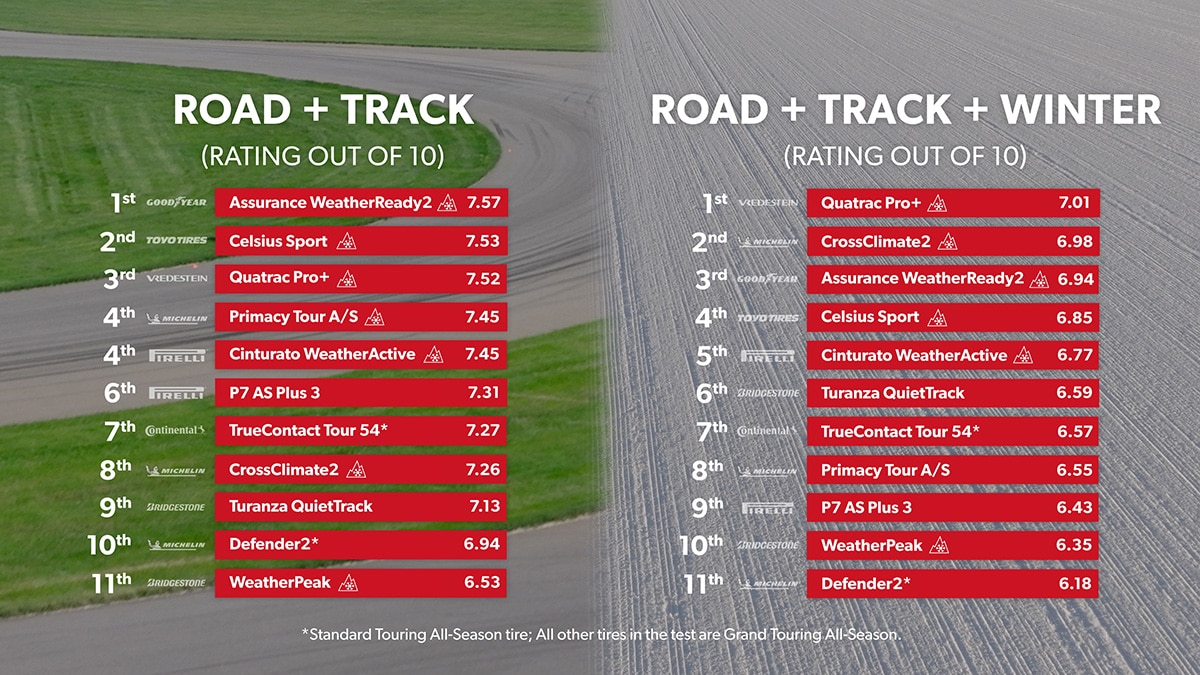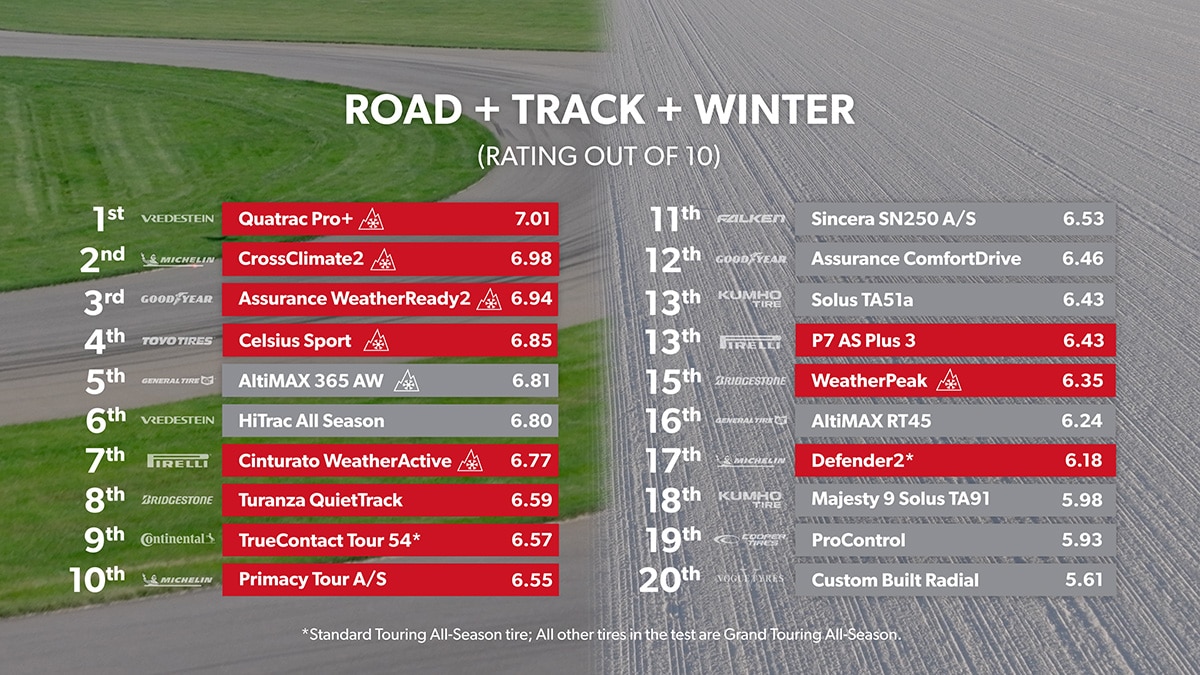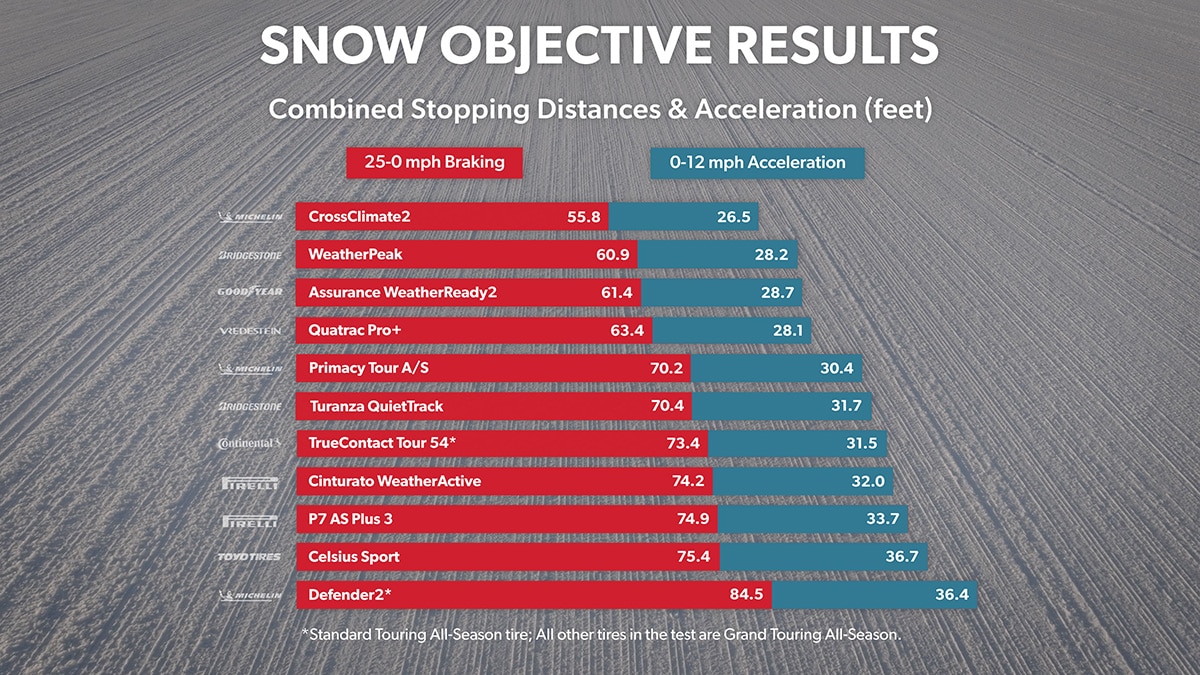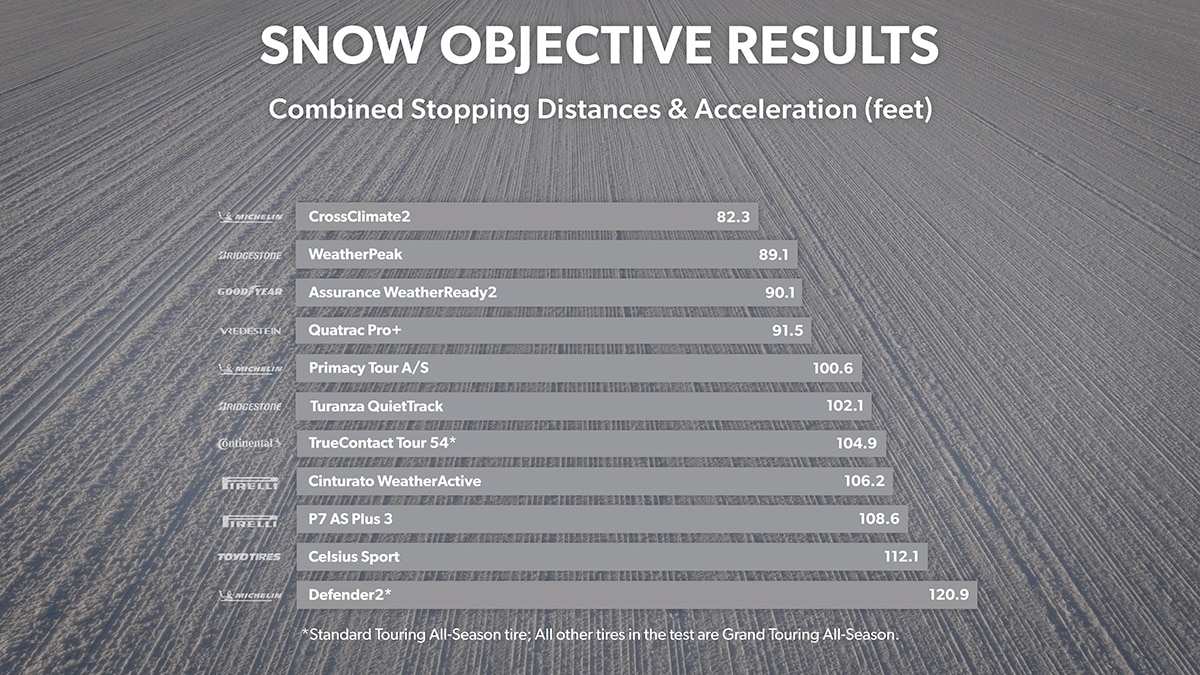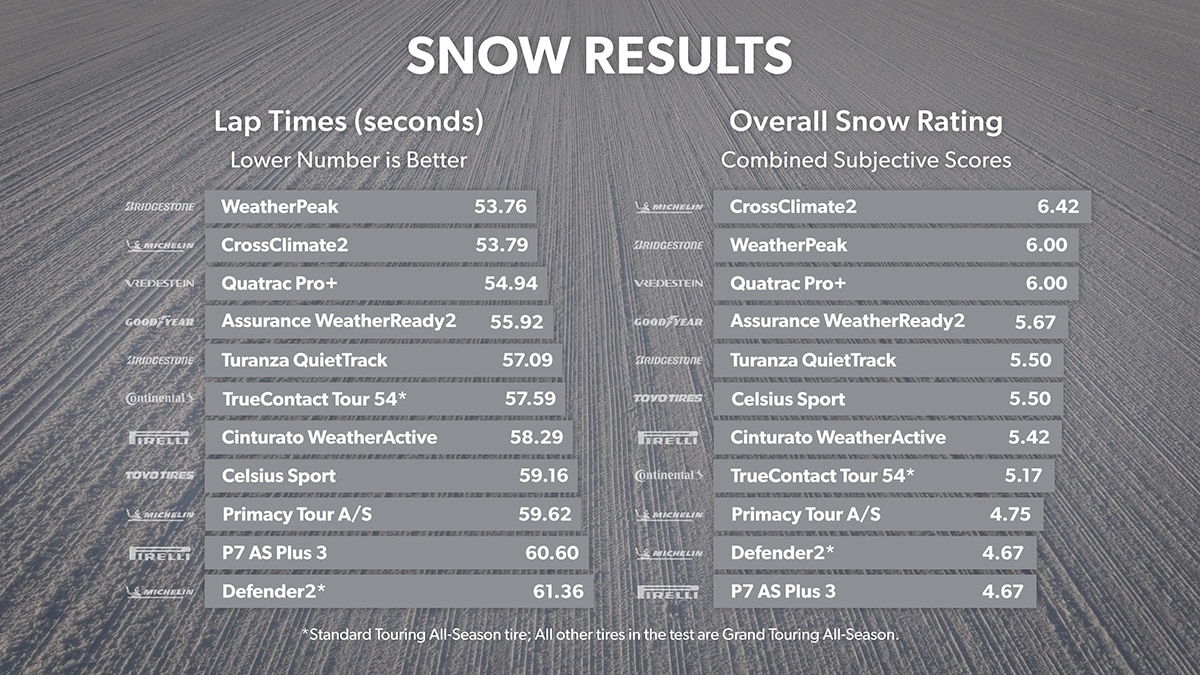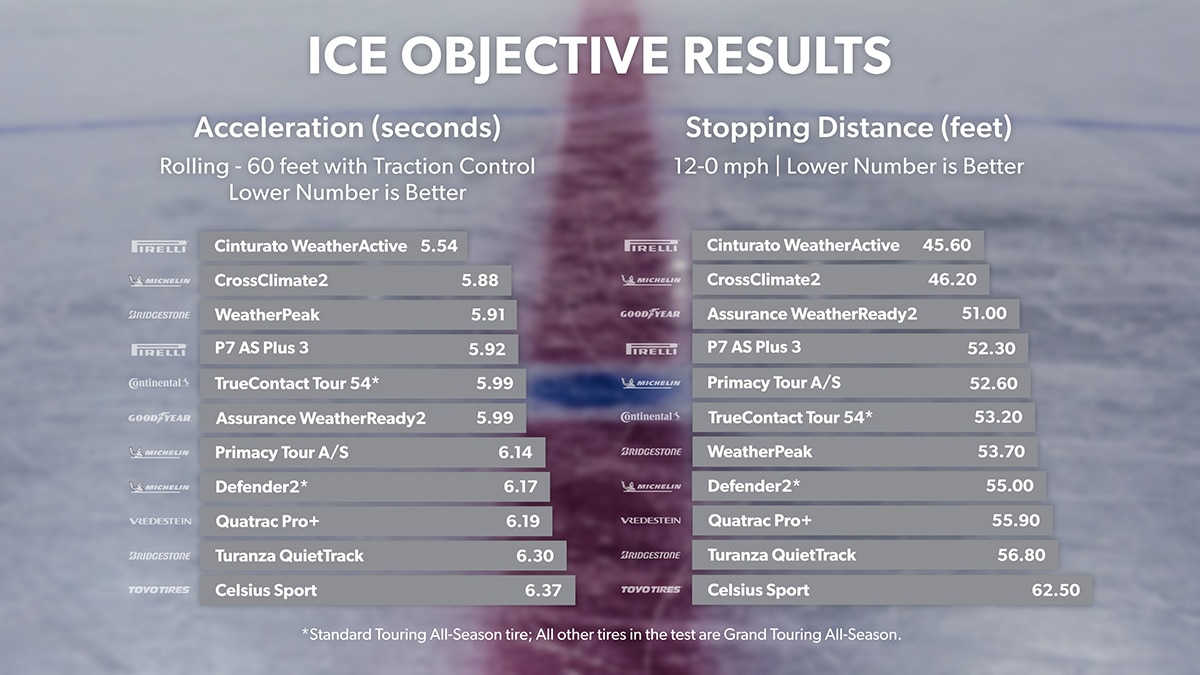Grand Touring All-Season (GTAS) tires comprise one of the biggest categories in the tire world, and most of us rely on their everyday utility to transport us between home, school, work, and every place outside of that. When we tested a group of them earlier this year, we knew just one test wasn't going to be enough. This is our second round of touring tests and includes two Standard Touring All-Season (STAS) tires in the mix this time. Compared to their GTAS counterparts, this category tends to focus more exclusively on tread life as a main feature while balancing comfortable road manners and all-season traction. The lines between categories can blur and overlap at times, and particularly in a case like the TrueContact Tour 54 (born from a fusion between both categories), it becomes particularly enlightening to see how a tire like that fits into the overall landscape.
Just like before, we'll be testing on our new 2025 Toyota Camry: the dependable workhorse of the automotive world. This Front-Wheel Drive (FWD) commuter should align with the behavior and characteristics most of us expect to get from our daily drivers. We'll introduce each tire, break down our experiences with them on our real-world road ride, and then discuss their traction and subjective behavior during wet laps to understand how they act when pushed to their limits, mimicking the kind of high-speed emergency maneuvers you might need to deal with in a sudden crisis.
In addition to the limit-pushing data and experience we gather from running laps, this test will reference our "emergency lane change" maneuver. On the dry track surface, from a target speed of 45 miles per hour, our drivers will pass through 3 sets of cones to illustrate how the tires handle the kind of sudden, reactive swerves a person actually makes in an emergency situation. The 1st set indicates the point a person would react to an obstacle (such as a stopped car or pedestrian) leaving the "lane." The 2nd set is the target placement to avoid the obstacle, indicating the lane change has succeeded. The 3rd set of cones represents the successful target for returning to the "lane." Afterward, we complete a dry lap to get a feel for their behavior, similar to our wet driving, just without a timed component.
Bridgestone Turanza QuietTrack
The name of the Turanza QuietTrack isn't just an expression of intent; it's also the name for the specific technology Bridgestone has molded into the grooves of the tread to minimize noise, part of their aim to create a capable and comfortable all-season tire. Our time during the real-world road ride was, in a word, comfy - impacts were very nicely rounded over, absorbing larger hits with ease and smoothing out what would typically be lighter, sharper imperfections. Noise was an interesting mix of tones, nothing approaching oppressively loud, but there were higher-pitched tones over crosscut concrete, deep growls over chip-and-seal roads, and a mix of mechanical patterns and impact slap at highway speeds. It was just enough noticeable variety to note that it didn't all blend into a cohesive white noise. The steering experience was on the lighter side but responsive at all speeds, transferring a solid sense of control to our drivers.
Putting these road-focused tires on the track to test their behavior at the limits of grip is always a critical testing step. In the wet, the Turanza QuietTrack felt competent in the broad strokes after a fashion. It took a bit of acclimation to account for a general lack of traction and mid-pack braking first, coming to a halt from 60mph 14 feet longer than the leader but still a good 20 feet shorter than the weakest tire in braking. It wasn't happy combining inputs, braking and steering simultaneously was right out, but properly separated, it was capable enough - helped along by its accuracy and responsiveness with each turn of the wheel. The steering felt just as good in the dry: natural and progressive, but we were still fighting with the traction. It was slow to recover from understeer and could snap into difficult-to-recover oversteer, neither of which made it easier to pass the Emergency Lane Change - something it only managed to do for half of our attempts.
Much like its dry and wet track performance, when it came to winter driving the Turanza QuietTrack was a solid, reliable average. It offered noticeable ability in mid-corner throttle application and adjustability. Lifting off the throttle helped tuck the nose, making it more responsive and manageable. While not spectacular, it allowed for good cornering speed, later braking, and some slight rotation. Acceleration and turning could be combined more effectively, though it still tended to push wide. However, it felt controllable and capable within its limits. Braking on the ice revealed it as one of the weaker tires among the group, though still around 8 feet shorter than the bottom rung.
Bridgestone WeatherPeak
The "all-weather" option from Bridgestone carries the three-peak mountain snowflake symbol on its sidewall, alluding to more focused snow performance than its counterpart. Still, winter isn't all year round, so how is it to drive in the non-frigid varieties of "all" weather conditions? The quality of the ride on the road was on the softer end of the spectrum, at the expense of some post-impact motion and slap over bumps. Tread noise was varied, with multiple tones on most surfaces, and even if the overall noise levels were relatively low, those individual drones, rings, and grinds were still noticeable. The steering response was a bit sedate - slow to start but decent once we moved off-center.
The switch over to testing its limits on our wet track was not encouraging: 60 to 0 braking was comfortably the weakest in the test, at 174 feet, which was still 12 feet further than even the closest tire. Naturally, this meant braking sooner to slow for turning appropriately, but then our drivers had to contend with its weaker lateral traction, sending it understeering wide through turns. The steering was responsive enough, if a bit vague, but it couldn't keep up without support from grip on the pavement. During dry testing, the experience was largely the same: lower grip, pervasive understeer, and trying to brake and turn were unpleasant and unstable. Even the steering, which had at least felt responsive in the wet, felt sluggish. It failed to make any successful attempts at the Emergency Lane Change.
Compared to its warm-weather behavior, the WeatherPeak felt much more capable on a snow-covered surface. Objectively, it had the second-best lap times and braking in the snow, while comfortably settling within the top group for acceleration. It was confident in turns and braking felt as nice as the numbers indicated, less likely to trigger ABS with careful application. Traction limits were simply higher, which made it much more manageable and less likely to surprise. It could still be coaxed into understeer, or a tail-out swing, but never felt like it completely gave up. It could be recovered with a little effort. Ice braking was good, among the upper-tier of the group at 53 feet from 12 mph.
Continental TrueContact Tour 54
A brand new tire for 2024 and one of only two Standard Touring All-Season tires in this test. This is Continental's fusion of two previous tire lines (the PureContact LS and TrueContact Tour) into a single product they claim improves on handling and wet performance over its predecessors while drastically improving tread life. It's a promising pitch for a premium tire, and we were looking forward to seeing if it could live up to the hype. The on-road ride quality was very positive over most imperfections, a bit firm overall for a touring product, but composed, with little to no post-impact jitters. The pattern noise was kept nice and quiet over most roads, just wind and the white noise, except for some of the coarser surfaces, where there was a bit of grind. Still, a good showing. The steering was direct and nearly immediate off-center while still feeling very nice rolling in a straight line.
Once we finished up with on-the-road driving, it was time to see how the TrueContact Tour 54 handled driving on a wet surface at the limit. One of the most immediately apparent takeaways was how quickly it turned laps - even though we publish times, we rarely draw attention to them outside of performance-focused categories, but particularly for a Standard Touring All-Season product, this was very competitive with the Grand Touring All-Season options. Traction was very strong in corners, and it was one of the better tires in the test for wet braking. It would be unfair to call it "athletic", but it was definitely capable. Once the track dried off, the experience was again not top-tier but competitive. Traction limits felt forgiving, and the steering was linear, natural, if not the most urgent. It was neutrally balanced, managing weight transfer during maneuvers like the Emergency Lane Change (which it did pass every time) in a meaningful, readable manner.
Even in the winter, the prevailing sentiment for the TrueContact Tour 54 held steady. It was good. Not great, not terrible, but good. Objectively, acceleration and braking were lower than some of the tires more focused on winter performance - namely any tire with a 3PMSF symbol on its sidewall - but it was also more capable than its Standard Touring All-Season counterpart as well as a couple of other Grand Touring All-Season tires. It had a wide, usable traction plateau, if not a particularly high one. It held on through the corners and, provided drivers were willing to slow down and stay within its limits, was largely acceptable. It was a similar story on the ice: at 53 feet to come to a stop from 12 mph, it remained competitive.
Goodyear Assurance WeatherReady2
Another one of 2024's newest tires, the Assurance WeatherReady2, is molded with a directional V-shaped tread pattern that, alongside Goodyear's AquaTred technology, is designed to maintain traction in all weather conditions. It looks the part, but its performance during a daily drive is just as important as how it handles unexpected weather, so we were excited to hit the road in this one. During our road ride, it was a stand-out option and our favorite in the test for pure ride comfort: soaking up large hits yet firm and concise over smaller impacts. The steering was direct and responsive at lower speeds and ramped up very nicely as the speed increased to an almost sporty degree. Noise was not quite as refined as the other aspects of the experience, with several tones rising to our ears over a variety of road surfaces: pattern interaction with concrete, short, cyclical beats at highway speeds on the asphalt, some low-volume, high-frequency tones on off-ramps and low-speed asphalt.
When we took the Assurance WeatherReady2 over to test its capabilities on the wet track, it proved the development put into its design was more than just marketing hype. The steering might not have felt particularly eager in this environment, but it was deliberate and consistent. It did what we needed it to do. Traction levels were some of the best we felt in the test - braking was strong, lateral traction in the corners was strong, and it felt solid and planted in every move, communicating every step of the way. The same was true once the track was dry - no drama; it just followed directions and complied. The steering was just as hefty and deliberate, and it delivered all the grip we needed. The Emergency Lane Change posed no problems, even during one of our driver's mistimed attempts where they came in too fast; it was reliable.
It remained a reliable option during winter testing - braking and acceleration were both objectively strong, competitive with some of the best in the test. It was easy to steer with direct response to input, it felt authoritative - lateral traction was well-matched, and it could hold the line during tighter turns. It was confident and secure throughout. Even during ice testing, it was among one of the better tires, holding at a 51 foot stop from 12 mph. Just a well-rounded performance overall.
Michelin CrossClimate2
The CrossClimate2 is one of the titans of the Grand Touring All-Season category. 31 million miles reported in customer reviews at the time of writing, continually at the top of the survey results, it is an undeniable benchmark. Like any good title-holder, that means it will be challenged often, both by the competition and our testing team. It was comfortable on the road - not the plushest in the test, but not so firm that it felt choppy, a pleasant ride in the middle. Its ability to control noise was within par for the category, not overly loud, but not without some intrusive tones particularly at highway speeds and on smoother roads. Steering was light and eager, taking little effort to change direction or move off-center. The liveliness is appreciated, but a bit more heft would be nice.
During wet track testing, the CrossClimate2 gave our team plenty of traction to play with, particularly in the straight portions, only two spots away from the leading tire in braking distances from 60mph. It was a little less assured in corners or on the skid pad when the steering could handle pointing the car where it needed to go initially before the grip let loose, and it would begin pushing mid-corner. It still felt stable enough through back-and-forth slalom maneuvers that an average driver wouldn't stress too much, but it wasn't domineering in its hold on the asphalt. The CrossClimate2 felt similar on the dry track - it was good and responsive but not quite as planted as we would like, pushing more at the front. Not in a major way, but enough to erode confidence just a bit. It passed the Emergency Lane Change every time.
Compared to every other tire in this test, the CrossClimate2 was a (relative) athlete in the snow. Acceleration and braking were simply, objectively, better. It stopped 5 feet shorter than the closest tire, hit its acceleration target 2 feet sooner. Higher speeds felt confident - control was easy to maintain, with only brief understeer moments and no major stability issues over multiple laps. Steering felt sharp, with lateral grip that supported better cornering speed and braking performance. On the ice, it was just under a foot off from the shortest braking distance in the test at 46 feet.
Michelin Defender2
The only other Standard Touring All-Season in this test, the Defender2, is a category classic. While, in very general terms, Standard Touring All-Season tires tend to emphasize longer treadwear and ride comfort than their Grand Touring counterparts and may sacrifice some performance to do so, neither statement is absolute. The reality can get hazy, particularly as tire technology advances, which is why we've included this tire, not because it competes per se, but because it's an excellent frame of reference across categories.
The Defender2 was good at soaking up little impacts on the road ride and kept most larger impacts brief, but there was definitely excess movement over regular undulations that could be felt in the cabin. Noise levels were on the lower end of the broad tire spectrum but middle of the pack here. A bigger issue was blending tones, as different surfaces introduced different secondary tones that joined the typical travel drone we expected. That two-tone experience was present in most rough and smooth pavement environments. The steering was the same level of firmness throughout, which didn't feel natural, but it was consistently precise. It took some extra input at lower speeds, which made it feel sluggish, although that largely tapered off as speed increased.
In the wet, the Defender2 was fair - it had enough lateral traction to handle cornering at higher speeds as long as our drivers stayed off the throttle. Too early, and it would understeer right out of the turn; a controllable variable on the track, but harder to deal with in real life for an unprepared driver in an unexpected situation. The steering feel was likewise adequate, pointy, and responsive enough, but it couldn't make up for the lack of grip. It was an issue that also continued on the dry track, with the Defender2 frequently pushing into understeer, particularly during the Emergency Lane Change. It managed the maneuver most of the time but was a handful during every attempt.
The Defender2 communicated its snow driving by objective scores just as effectively as any discussion about its behavior. Coming to a stop from 25mph took the longest at 84.5 feet, a full 10 feet further than the closest tire, and nearly 30 feet from the best in the test. Acceleration was a touch more encouraging, though it still wouldn't be considered strong among this group and struggled to put down power in a straight line, or at corner exit. Understeer was a prevalent feature of the drive, pushing during corners. It was still largely controllable at lower speeds, and it is worth considering this was a different category than (most) of the other tires here it was being outclassed by.
Michelin Primacy Tour A/S
It's been a few years since we last reviewed the Primacy Tour A/S back in 2019, and while it might not have taken the world by storm at that point, we found it to be a decent category option with few weaknesses but little to stand out either. It's time for another look to see how it fits in the tire world of today. The real-world road ride was on the firmer side of the spectrum, which made the larger impacts more noticeable, but it managed to smooth over a good portion of the ride. It did a nice job keeping the volume of noise down, blending tones down to a soft, generic hum on most smooth surfaces, but it did pick up some additional tones when rolling over coarse concrete or chip-and-seal roads. The steering was accurate and light, with a fairly minimal on-center feel.
Putting the Primacy Tour A/S through its paces on a wet track felt very good - helped significantly by some impressive traction. Coming to a straight-line stop in the wet from 60 mph yielded the shortest braking distances in the test. The steering was responsive, eager to move and follow commands, with enough traction to take full advantage of it without understeering or wandering into unpredictability. The steering felt just as good once the track dried off, crisp and reactive, almost performance-esque, which was a bit surprising for this category. The traction fall-off over the limit felt a little more knife-edged and less progressive than some of its peers. It did pass the Emergency Lane Change every time, even if it felt a little close during a couple attempts.
The Primacy Tour A/S was not quite as encouraging during winter testing. It struggled to put power down, requiring careful steering and patience with throttle to avoid pushing wide at corner exit. Ascending the track's hill was difficult, with the car crabbing sideways under throttle. The 180 demanded significant slowing to stay on line. Objectively, it took just over 70 feet to come to a stop from 25 mph in the snow, and was one of the weaker tires in the test. Ice braking was at least reasonable for the group, taking 52 feet to come to a stop from 12 mph.
Pirelli Cinturato WeatherActive
The Cinturato WeatherActive is another Grand Touring All-Season tire that could easily be considered one of the category's shining stars; it's done well in previous testing, and customer reviews, while still early, have been glowing. It's our first test of this one on the Camry platform, and we were excited to see if it would hold up. During our time testing on real-world streets, it offered a firm, composed ride, absorbing small bumps and imperfections smoothly while curtly handling larger impacts. Noise levels were extremely well-controlled, with subdued volume across various surfaces, even accounting for low underlying sounds on asphalt and minimal resonance on crosscut concrete. On smooth surfaces, it performed especially well with only light noise. Steering was responsive and natural, with no dead spot, providing a balanced and straight tracking feel.
In the wet, the tire provided traction that ranged from decent to good alongside responsive, precise steering. Braking from 60 mph was the 2nd best in the test, and overall, it felt well-balanced, making use of everything it did well. The lateral grip could have been a little stronger, and it struggled to combine steering while braking, but overall, it still fell within the upper-mid range of tires tested. In the dry, it didn't feel quite as responsive over the limits; once we were past that point, the understeer could push until the front caught, and then it would pivot sideways. When kept under that point, it was decent, and the steering felt nice enough, but attempting the Emergency Lane Change was a 50/50 proposition, and the lack of front-end authority didn't make the failure feel predictable.
With snow on the ground, longitudinal grip felt assured, delivering confident, if not earth-shattering, acceleration and braking. Lateral grip was solid but a bit less impressive compared to its straight-line behavior. It wasn't bad, on the contrary, there was a wide enough window to recover from small mistakes with some careful driving. The front would give up first when pushed - so understeer could be expected, but kept within its limits, it was generally well-behaved. It was also comfortably the strongest tire on the ice, coming to a stop nearly a foot ahead of the closest tire, and just over 7.5 feet shorter than the test median.
Pirelli P7 AS Plus 3
This entry in Pirelli's long-running and popular P7 line has kept customers happy, with 4.5 million miles reported in customer surveys and tested well enough with our team in the past on our RWD Subaru BRZs. Now, it's time to see how the experience holds up on our new FWD Toyota Camry. One of the most immediate takeaways from the road ride was its comfort. It was a little on the firm side but did an excellent job rounding over bumps, communicating the road, and smoothing over imperfections without disturbing the cabin. It treated noise similarly, quieting down most tones to a nice, even white noise on par with the wind. The steering was a bit lighter than we'd like but it was responsive, tracking nicely along during the whole run.
The impressive road ride was dampened a bit, both literally and figuratively, when we switched over to wet testing. The steering continued to feel good, responsive and athletic, but overall traction was simply down everywhere it mattered. Braking from 60 mph was the 2nd to last in the test, more than 20 feet off from the leading tire. It wasn't just longitudinal traction either; it could be felt in the lateral grip, too. While it could be usefully rotated through portions of the track, "useful rotation" isn't a comforting phrase to consider when driving the kids to school in the morning (though you should slow down if that's the case). Once the track dried off, it felt better, more compliant, and better behaved. The steering continued to be a highlight, with eager responsiveness and appropriate precision. It passed the Emergency Lane Change almost every time, but not without some focused effort needed.
The P7 AS Plus 3 was decent when it came to winter driving, though nowhere close to exceptional. There just wasn't a lot of traction to work with, and it showed in objective numbers - it was the second slowest during laps, and near the bottom when it came to acceleration and braking figures. It used what it had well, controlling easily through turns and directional changes within its lower limits. Its behavior on the ice was likewise moderate - mid-pack, not bad, not great.
Toyo Celsius Sport
The Celsius Sport is among the younger generation of all-weather entries into the Grand Touring All-Season category, an extension of Toyo's Celsius line of all-season tires, with a focus on blending sporty performance with daily utility. The road ride experience was definitely on the firmer end of the equation, in line with the "sport" part of the moniker, meaning bigger impacts were more significant than most of the tires tested. There was more impact noise to go along with the harder hits, and tonal variety was more insistent over most surfaces, not really fading into the background. It was fine over smooth surfaces and wasn't loud, per se, but more noticeable in relation to its competition. The steering was very quick to respond, requiring some of the least input to react of any of the tires we tested. It felt eager to move.
The Celsius Sport came alive when we took it for a drive on our wet track, almost reminiscent of a performance tire. The steering continued to feel light, precise, and highly responsive. Lateral traction was mostly able to keep pace as well. There was plenty of grip available in the corners. We don't typically focus on lap times in touring categories, but a fast time is typically an indicator of strong, controllable agility in the wet, and the Celsius Sport put up the fastest average times in the test. It was equally capable once the track dried off, too - with sharp steering and ample communication with our drivers. It let us know when it was getting close to the limits and gave our drivers a chance to rein it in rather than just abruptly pushing into understeer, which is typical for this category. It did take a while to recover over the limit, though. It handled the Emergency Lane Change effortlessly every time.
During snow driving, the Celsius Sport performed well across the board, with responsive steering, confident braking, and solid acceleration, at least when throttle inputs were controlled. Excessive throttle quickly pushed it wide. It may not be reflected in its objective scores exactly, but the overall experience was manageable enough to raise its esteem among the group. Ice was a particular issue for the Celsius Sport however - it took significantly further to stop than every other tire, at over 62 feet, with even the closest tire having halted over five-and-a-half feet prior.
Vredestein Quatrac Pro+
Another player in the all-weather space, the three-peak mountain snowflake branded Quatrac Pro+ is an updated version of Vredestein's popular Quatrac Pro, a tire we've also tested and enjoyed previously. The updates are mainly aimed at improving rolling resistance and snow performance, which we'll revisit later on - for now, we'll see how it stacks up in the current landscape. The road ride experience on the Quatrac Pro+ was pleasant - it was firm enough that larger bumps were noticeable, but the smaller or more repetitive elements in the road felt as if they were smoothed away. The typical road noise was kept to a merciful minimum across most surfaces, even some of the rougher portions of the route. It blended together common hums and grinds into a singular low-volume tone. The steering response was lively enough, not the sportiest in the test, but it built effort smoothly, naturally, ideal for the category.
The time spent on our wet track was positive, and saw the Quatrac Pro+ on par with the best in the test, able to find grip and apply power even under these lower-traction circumstances. The Quatrac Pro+ felt agile; the steering was pointy and authoritative, and it was in its element here. Once the track dried off and we could attempt the Emergency Lane Change, it was a bit more speed-sensitive, only passing the maneuver half the time. It seemed to hit that limit right around 45mph. Just a little over, and it would fail, push, kick the rear end out, or, in some way, cause trouble. Right on, or just under, and it was fairly easy, but the quirk deserves note.
The Quatrac Pro+ was absolutely in its element on the snow - with objective braking and acceleration not only numerically challenging the best, it also felt confident and controlled. Braking in particular was authoritative. Moreover, its lateral control was forgiving, with room to recover from too much speed or delayed inputs, it always seemed there was just enough reserve traction for corrections. It wasn't special on the ice, merely middle-of-the-road there, but overall, this was a strong showing for the tire.
Summary Conclusion
For a lot of people, these are "set it and forget it" tires that will be driven for years at a time (with regular rotations, of course.) That also means that drivers will live with them that whole time, too - a quiet, comfortable tire is just as critical to keeping your sanity intact as their ability to hold onto the road is to them keeping your car intact during an emergency. That's the expectation with touring tires and one of the critical lenses we make sure each and every tire is viewed through when we test. Outside of a couple of products that could use improvement, most of the tires in this test still comprise the best-of-the-best for the touring world and the margins separating them are thin.
Few tires exemplified that better than Vredestein's Quatrac Pro+, which distinguished itself with an above-average road ride, and exceptional (for the category) wet and winter performance. We'd like to see some adjustments in consideration of its dry performance for any future iterations, but it was capable enough to make a strong impression overall. Michelin's CrossClimate2 has been a benchmark product for the category for a long time, and remains an excellent "go-to" consideration for a set of tires for any weather condition. It has earned every bit of credit it gets for establishing the bar that much of the competition has risen to, and in some ways continued climbing beyond. Speaking of "rising beyond" - Goodyear's Assurance WeatherReady2 - we've used the phrase "jack of all trades" to refer to many of the more generalist tires before, but that's selling this tire a bit short. It was great nearly everywhere we took it - it was plush on the road, with excellent handling, and a true top-tier category option when stressed to its limits on the track. It was a noticeable step above most of the tires in this test in the snow, even if it wasn't the absolute best. We'd love to see a little improvement in overall noise comfort, but even that was fairly good. Toyo's Celsius Sport is another tire that has earned equal consideration, with test-leading performance and handling on the track coming with a small price of a step down in comparative on-road comfort and winter performance.
The Cinturato WeatherActive from Pirelli deserves special mention for providing the nicest road ride in the group with very quiet travel over most roads and excellent composure. Unfortunately, its performance in wet and wintry conditions was just middle of the group, despite some strong braking, and its ability to handle dry maneuvers like the Emergency Lane Change, were lacking. Bridgestone's Turanza QuietTrack is a stalwart member of the touring class, just an all-around good tire. It's a category workhorse that isn't as loudly exceptional as some of its competitors - in both a literal and metaphorical sense - but avoids many critical pitfalls along the way as well. Continental's TrueContact Tour 54 occupies a similar, but particularly interesting place in this test. It was designed to take the qualities of two tires from Continental's Standard Touring All-Season and Grand Touring All-Season categories and fuse them into one that exists between worlds. It seems the experiment was a success - it certainly fits the "jack of all trades" model - not truly excelling in any one metric, but managing to be a good tire in every respect.
The Michelin Primacy Tour A/S had leading braking numbers from 60 mph in the wet, and was great on the track, proving it could handle everything from a sedate Sunday drive to swerving around commuters in the rain. However, it wasn't quite as confidently agile in the winter, and could use a bit livelier steering and on-road refinement to bring it up a notch. Pirelli's P7 AS Plus 3, deserves to be mentioned right alongside its cousin for having an excellent road ride and performance characteristics. Its wonderful steering really complemented the tire when it was dry, but struggled in the wet and snow compared to its rivals. Finally, Bridgestone's WeatherPeak and Michelin's Defender2 were certainly acceptable for their respective categories when looking at the broader picture, but neither really rose to the level of competitive with this selection of tires. The WeatherPeak absolutely deserves kudos for its winter performance, and was one of the best in this group for that specific environment, but it still has to contend with driving the rest of the year. Likewise, as a longevity-focused Standard Touring All-Season option, the Defender2's only real direct category competition here was the TrueContact Tour 54. However, with respect to the WeatherPeak and Defender2's on-the-street comfort, and dry/wet performance, they were simply a step down in most regards to the upper echelon of tires they were compared against here.

